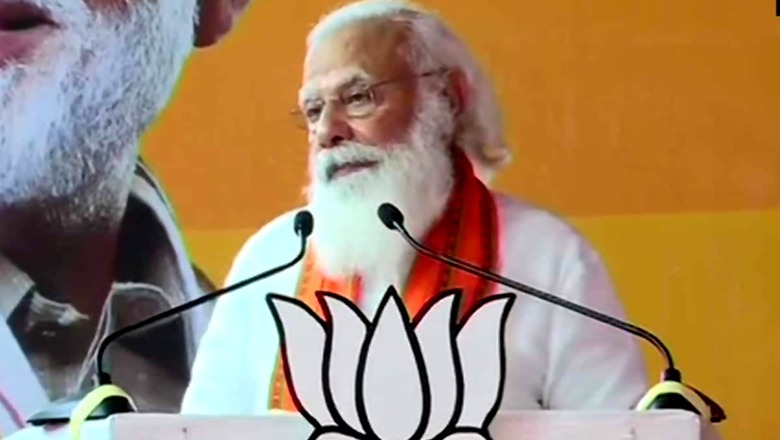
views
It’s little more than a dot on the Indian map and has a lone representative in Parliament. Yet, the April 6 election in the Union Territory (UT) of Puducherry presents a riveting political canvas of fast-changing contours.
There is now a new colour, saffron, which is shining bright in its skyline dotted with party flags, as well the wall space for publicity materials such as political posters and election graffiti.
Prime Minister Narendra Modi has made two campaign trips to this UT, and his battle commander, Union home minister Amit Shah, has lent his thundering rhetoric to the canvassing here. In order to win over voters and do away with their Congress obsession, the Bharatiya Janata Party (BJP) has promised milk and honey, while telling the electorate that the party of the Gandhis is a gone thing.
And here comes the punchline: a poll victory in Puducherry could be the springboard for the BJP to dive into the seat of power in neighbouring Tamil Nadu, where the two Dravidian majors, the Dravida Munnetra Kazhagam (DMK) and the All India Anna Dravida Munnetra Kazhagam (AIADMK), have been holding the fort — the Secretariat at Fort St. George, rather — since 1967, when the Congress lost the elections.
The saffron plan is to usher in huge development and infra projects into the tiny UT, create jobs, and lift the standard of living after ensuring the victory of the alliance featuring the BJP. This, the saffron camp hopes, will mean that voters across the borders in Tamil Nadu will burn with jealousy and end up craving for the lotus (the BJP’s poll symbol). In that case, the 2026 election could be a good harvest time.
At his February 25 rally in Puducherry, PM Modi pronounced “in brief” his vision for the UT. “I would say I want Puducherry to be the best; the NDA (National Democratic Alliance) wants to make Puducherry the best. ‘B’ for business hub, ‘E’ for education hub, ‘S’ for spiritual hub and ‘T’ for tourism hub.” The seaside former French colony is a destination for spiritual pursuit and tourism. Modi visited its famous Auroville and meditated at its splendid Matrimandir (the mother’s shrine) two years ago, coincidentally on the same day (February 25).
Let’s go back in time, just a bit. As the new year began, Congress chief minister V Narayanasamy was locked in a long battle with lieutenant governor Kiran Bedi. He was convinced that the Centre had sent her to derail his regime in the UT, after she lost the Delhi elections as the BJP’s CM candidate. Narayanasamy must have breathed easy — albeit briefly — when President Ram Nath Kovind apparently acted on his petition to recall Bedi.
But then, by the time she got the marching orders on February 16, the CM had already come under scorching saffron heat with two of his MLAs crossing over to the BJP camp a fortnight earlier. One of them was A Namassivayam, the influential number two in the cabinet.
Already, the Congress’s comfortable majority comprising 15 of its own MLAs and two of ally DMK had gone rickety. In July 2017, Bedi had inducted three BJP leaders as nominated members in the assembly, where the party had no representation until then. The Supreme Court refused to scrap the move, which took the House strength to 33.
Senior Congressman and minister Malladi Krishna Rao, who represented the UT’s Yanam constituency (it is geographically in Andhra Pradesh), quit the government, the party and his assembly seat just days before Rahul Gandhi’s February 17 visit to the UT. Gandhi — whose trip was aimed at shoring up the party’s campaign and, more importantly, pep up the family loyalists’ slipping morale — did precious little to stall the quake. His interaction involving Narayanasamy and common people ended up becoming a disaster, with the media heavily criticising the CM for allegedly “mistranslating” a fisherwoman’s angry complaint against his administration as a sweet compliment. The visiting Congress leader’s appreciative nods only added to the laughter, and anger, that reverberated even at PM Modi’s rally that followed a week later. Home minister Shah, who too descended on Puducherry’s Karaikal town for a BJP rally around the same time, took a jibe at Narayanasamy and accused him of lying.
Meanwhile, after Bedi was gone, the Rashtrapati Bhavan asked Telangana governor Dr Tamilisai Sounderarajan to hold the additional charge of Puducherry. She had been the state BJP president in Tamil Nadu until she got the Hyderabad job in September 2019. Around the same time, the DMK lost one of its two legislators to the BJP.
The CM opted for a floor test in the assembly and contended that the three nominated BJP members had no voting rights, which was turned down by Speaker VP Sivakolunthu, a Congress leader who later resigned on health grounds; his brother has already joined the BJP. With Narayanasamy staging a walkout, the Speaker announced the defeat of the confidence motion. Soon after, lieutenant governor Tamilisai recommended President’s rule.
The government’s collapse on February 22 rekindled in the Congress camp memories of similar saffron schemes that had unsettled rivals in other parts of India. “We had chosen Pondicherry (Puducherry) years ago as our springboard to leap into the South…That’s why we fielded BJP candidates in all 30 constituencies here in the last (2016) assembly elections. We wanted to prepare ourselves down the line,” says a saffron senior, requesting anonymity.
Indeed, the BJP’s preparations for the South have been lengthy. No other PM had visited Puducherry more than once; after his spiritual journey to Auroville in February 2018, Modi made two campaign trips to the UT, on February 25 and March 30. While Shah ripped through the Congress-DMK team at his Karaikal rally on February 28, BJP national president JP Nadda visited the UT at the end of January. They all spoke of the kamalam (lotus) that the BJP hopes will bloom in Puducherry, and of the Congress collapsing across the country.
Unlike Tamil Nadu, where the DMK and the AIADMK has ruled for decades, Puducherry almost always favoured a national party—the Congress in this case, since the BJP hardly tried building itself on the Dravidian turf until now. Since the UT is administered by the Centre, its electorate preferred a national party with an eye on getting development and infra projects. Now, the BJP is confident of being part of the next government it believes would be led by the All-India NR Congress (AINRC) of N Rangasamy, and even sees a chance to lead the government in case of a hung House.
For the Congress, Narayanasamy’s fall meant the dropping of the lone little fig leaf in the South. In Kerala, which is also going to polls on April 6, the ruling Left Democratic Front (LDF) could break the state’s four-decade-old tradition of rival fronts alternately forming governments; opinion polls have predicted the Congress-led United Democratic Front (UDF)’s loss. “The Congress will remain on its course downslide across the country, so long it’s a one-family party. We must soon get worried about complacency and boredom creeping in, as we run out of real challengers,” says another BJP leader, exuding confidence that the South would soon turn saffron.
But then, the BJP has just about 2% vote share in Tamil Nadu and no presence in the present assembly there. Pollsters say it is unlikely to improve on its single-legislator score in neighbouring Kerala. “Never mind all that,” says the BJP functionary. “We had only three MLAs in West Bengal (where elections are underway), but now we are forming the government. We have a road map for Tamil Nadu too. There is a vacuum here after Jayalalithaa and Karunanidhi (former AIADMK and DMK chief ministers). Besides, people here are sick of all this corruption…they want development, they want jobs and all-round progress. We can deliver that. The anti-Modi sentiment stirred up by some vested interests has evaporated.”
Some hardcore BJP baiters see a “diabolical” plot to capture power on the Congress rubble in Puducherry, and are wary of saffron plans to go big in Puducherry in order to eventually dislodge the Dravidian majors in Tamil Nadu. “They will pump in big projects into the Union Territory, develop the Karaikal port real huge, bring in investments in all sectors. They will use all that…to woo the people in Tamil Nadu,” a pro-DMK participant said in a recent TV debate on the Puducherry events.
Postscript: The UT is non-contiguous and has four parts. Its capital, Puducherry, is a small coastal town spanning 20 square kilometres and close to Villupuram in north Tamil Nadu. Karaikal, another coastal town bordering Tamil Nadu, and its adjoining areas span across some 160 square kilometres. Mahe, less than nine square kilometres, is on Kerala’s Malabar coast. Yanam (30 square kilometres) is in the East Godavari district of Andhra Pradesh.
Read all the Latest News, Breaking News and Coronavirus News here. Follow us on Facebook, Twitter and Telegram.

















Comments
0 comment